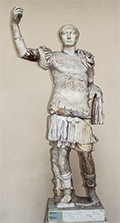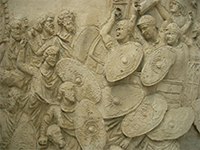Ancient Rome's Wars with Dacia
Dacia was a kingdom in what is now Romania and was an enemy of Rome in ancient times. 
Burebistas is credited with founding the Kingdom of Dacia, in 80 B.C. It was he who brought together, mostly through conquest, a number of neighboring lands, routing a few Celtic tribes and seizing a few Greek cities in the process. He continued to expand his kingdom and eventually came into contact (and conflict) with the Roman Republic. Burebistas died in 44 B.C., the same year that Julius Caesar, who was said to have been planning an invasion of not only Dacia but also Parthia. Without the iron hand of Burebistas, the lands of Dacia were once again independent. Other than a few sorties by Augustus, no conflict between Dacia and Rome took place for several decades. Dacian forces under King Duras achieved complete surprise by invading Moesia in 85 and killing Oppius Sabinus, the governor and a former Roman consul. The emperor Domitian responded with force, and the First 
Another emperor, Trajan (right) wasn't willing to settle for peace and marched into Dacia in 101. Again the two powers clashed at Tapae; this time, Rome was victorious. A few skirmishes followed, and the two powers agreed to another peace the following year, during which Trajan had built across the Danube the largest bridge for many a year.  The peace didn't last. By 105, Decebalus was agitating again and Roman forces invaded again the following year. They were much more successful this time around, capturing Sarmizegetusa, the Dacian capital, in the summer of 106. Decebalus refused to submit, preferring to perform a self-execution. The Dacian forces fought on and finally succumbed at a later battle, at Porolissum. Rome took possession of Dacia and enjoyed the fruits of its gold mines for years to come. Trajan, meanwhile, had built the famous Trajan's Column near the Colosseum in Rome. |
|
Social Studies for Kids
copyright 2002–2025
David White



 Dacian War began. Despite sending five legions, Domitian couldn't avoid an ambush and Dacian troops under Decebalus (left) routed the Romans at the Battle of Tapae. Rome pressed on and turned the tables, winning a victory that convinced Decebalus to sue for peace. Domitian, needing the legions to put down a revolt in Germania, accepted.
Dacian War began. Despite sending five legions, Domitian couldn't avoid an ambush and Dacian troops under Decebalus (left) routed the Romans at the Battle of Tapae. Rome pressed on and turned the tables, winning a victory that convinced Decebalus to sue for peace. Domitian, needing the legions to put down a revolt in Germania, accepted.
